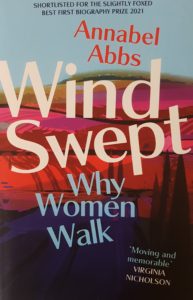On my final evening, the sun sinks behind the hills in a burst of fuschia-pink, lilac, gold. The moon appears, a cratered wafer of ice in a blue-black sky. I walk through the trees, listening to the chitterings and scufflings of countless invisible creatures, breathing in the scent of pine needles, sap, earth. I take off my shoes and feel the soft soil on the soles of my feet. A zigzag of breeze picks at my hair. I feel slightly unmoored, as if I’ve unexpectedly lost and found a part of myself. As if I’ve taken off an old dressing gown and discovered myself in sparking evening dress instead of dirty pyjamas.
 I recently took myself off to Queenscliff, near the entrance of Port Phillip Bay, for a couple of nights by myself. ‘Carer’s leave’, a friend called it; my husband has just recovered from over a month’s intense agony from a trapped nerve. Equally, he probably needed a respite from being cared for. Windswept: Why Women Walk by Annabel Abbs was my solo travel book.
I recently took myself off to Queenscliff, near the entrance of Port Phillip Bay, for a couple of nights by myself. ‘Carer’s leave’, a friend called it; my husband has just recovered from over a month’s intense agony from a trapped nerve. Equally, he probably needed a respite from being cared for. Windswept: Why Women Walk by Annabel Abbs was my solo travel book.
It was enthralling, inspiring, moving – but also (as I’m often finding as I age) dispiriting. The female walking alone provoked a range of reactions from men (and some women, too). Incredulity, disapproval, abuse, harassment, the threat of assault or rape, a refusal to sell food or let a room for the night. It may seem like a childish thing to say, but there is so much about being female that is just not fair. And it’s not about being female, exactly; it’s about being female in a patriarchal society.
Which is probably most of the planet, when you think about it. Sigh.
But back to the book. Windswept is a mix of memoir, travel writing and biography, organised around the theme of women who go rural or wild walking. Abbs recreates some of their journeys, travelling within Europe and Scotland and the US. Along the way, she reveals her subjects’ biographies and her own.
First, she walks with Frieda Lawrence in the Alps, describing the boldness with which Frieda escaped her suffocating marriage in Nottingham to go wandering in the Alps with her lover, DH Lawrence. Though the severing of the tie with her three children broke her heart, Frieda used the freedom of those days and nights to recreate herself. For Abbs, at a period in her life when her children are beginning to leave home and her role as a mother is diminishing, Frieda’s walk arouses strong feelings.
Walking the route of a woman renouncing her children, obsessing…why the sudden preoccupation? It took me three years to see that Frieda’s walk was also mine, an unbidden step in my own casting-off.
The other walkers are an equally fascinating group. Four of the women walked mainly in France. Simone de Beauvoir (bizarrely – for me, anyway, because I love a pair of sturdy boots – in espadrilles); Daphne du Maurier; Clara Vyvyan, a now-forgotten writer, and Gwen John, sister of the artistic powerhouse Augustus John.
Gwen was an artist in her own right but overshadowed by her more famous brother and burdened by family life. Intriguingly, she is probably the better known artist now. Desperate for solitude and peace, she walked alone and occasionally with a woman friend, lugging her painting gear along the rivers of France. Other subjects are the artist Georgia O’Keefe in the vast, bleached landscapes of New Mexico and Texas and writer Nan Shepherd in the Cairngorm mountains of Scotland.
Is this a genre? ‘Women Walking’? I can think of Rebecca Solnit, Olivia Laing, Cheryl Strayed, Robyn Davidson – and there are probably many more now. I don’t know that I will be adding to them, but after reading Windswept, I’m actually feeling a little more emboldened. Not that I’m thinking of hiking the Larapinta Trail, or anything quite so gruelling. But after a couple of days spent pottering about the beach at Queenscliff, dabbling in rock pools, finding shells, becoming wind-burned and windswept – I can see ahead more little solo trips, more meditative walks and more essential de-cluttering of the mind in nature and solitude.

And of course Raynor Winn, who is so devisive! (That word looks wrong but I think it’s correct.)
The walk provides such a good structure for a meditative book because it gives movement and change and direction for the narrative, even if the story is mostly an internal one.
I can think of at least one friend who would probably love this book.